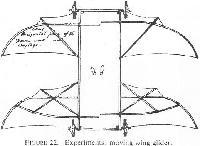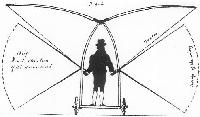
Описание
Страна: Великобритания
Год: 1852
Планер (проект)
P.Lewis British Aircraft 1809-1914 (Putnam)
Cayley 1809 Glider
Following his experiments with models and the consequent establishment of a practical form of man-carrying aircraft, Sir George Cayley had by 1809 constructed a full-size glider. The area of the lifting surfaces was 300 sq. ft. and, with a loaded weight of 140 lb., this gave a wing-loading of just under 1/2 lb. sq. ft. Tests at Brompton Hall demonstrated that the machine was quite stable and that it would glide downhill in any direction dictated by its rudder. These trials were unmanned, but Cayley claimed that, when anyone ran forward with it at full speed into a gentle breeze, the glider's lift was so strong that it would often rise and bear the runner aloft for several yards at a stretch. Before further investigations could be carried out with the machine, it was accidentally broken.
Cayley 1849 Glider
Forty years elapsed between the building of Sir George Cayley's full-size unmanned glider of 1809 and his man-carrying glider of 1849. In the interim, many varied ideas for the advancement of the science of flight passed through his fertile mind and were committed to paper in his notebooks.
The details of the form of this later machine are the sole known particulars to have survived of the earliest aircraft constructed with the express intention of carrying a man. An examination of the glider reveals immediately the remarkably high level of practical aerodynamic knowledge which had been reached as a result of his work. The machine was a triplane with a total wing area of 338 sq. ft., the surfaces being set with dihedral to assist lateral stability. The boat-shaped nacelle was suspended below the wings by struts and was braced with wires. The glider rested on an undercarriage of three tension wheels, two of which were at the front, while the third was at the rear. Longitudinal stability was ensured by a fixed tail plane and fin, the complete unit being mounted at the trailing-edge of the centre wings and adjusted in incidence by cords from the nacelle. Control in flight was effected by a duplicate combined elevator and rudder mounted below the upper unit and pivoted at the rear of the nacelle, operation being by the pilot's hand on the lever to which it was attached. Two levers, fitted vertically in front of the pilot, were connected to a pair of smaller flapping wings, each of 6 ft. span, which Cayley designed for the purpose of observing their effect on the gliding angle.
During 1849, the triplane glider was flown at Brompton Hall unmanned in ballast, and also succeeded in gliding several yards downhill with a ten-year-old boy on board on two occasions. In his notes made a few years after the event, Cayley refers to the machine as "the old flyer”. Weight empty, about 130 lb.
Cayley 1853 Glider
Sir George Cayley's glider of 1853 represented the culmination of some sixty years investigation into the realm of flight, which earned for him recognition as the inventor of the aeroplane in the form in which it finally evolved. The exact details of this machine remain to be determined, but it is understood to have been not a monoplane but either a biplane or a triplane, with the triplane the likeliest layout for the wings. The rest of the airframe is believed to have followed closely that of the 1849 glider, and to distinguish the later aircraft from the earlier, it is referred to in the Cayley notes as "the new flyer '.
In 1853 Cayley persuaded his coachman to make the first known manned gliding flight, which covered a distance of some 500 yards across the small valley at Brompton Hall, the family seat near Scarborough, Yorks. Weight empty, about 165 lb.
Описание:
- P.Lewis British Aircraft 1809-1914 (Putnam)
- M.Goodall, A.Tagg British Aircraft before the Great War (Schiffer)
- A.Andrews. The Flying Machine: Its Evolution through the Ages (Putnam)
Фотографии
-
A.Andrews - The Flying Maschine: Its Evolution through the Ages /Putnam/
Qantas reconstruction of Cayley’s ‘boy carrier’, or Old Flyer, the triplane in which he floated a ten-year-old off the ground in 1849, the first time a human being had left the ground in a heavier-than-air machine. The wing-span was 10ft, overall length and height 20ft.
-
A.Andrews - The Flying Maschine: Its Evolution through the Ages /Putnam/
Sir George Cayley’s model glider of 1804, seen here in accurate reconstruction, offered roughly twice the wing area, and had its cruciform tail unit set at a positive angle of 11 1/2 degrees to the rod forming the main horizontal beam, and the kite-form mainplane set at 6 degrees to this beam. Cayley wrote, with some exaggeration, that with this configuration ‘it would proceed uniformly in a right line for ever’. Penaud’s Planophore, which did not ‘proceed for ever’ but did fly 131ft in 11 seconds before the gravest technical witnesses, enshrined in the minds of the French, who were the most serious aircraft designers in Europe, the ideal of predominant equilibrium, or inherent stability, which culminated in the BE2c of Great Britain.
-
P.Lewis - British Aircraft 1809-1914 /Putnam/
Sir George Cayley's 1849 triplane glider flown briefly with light loads.
A sketch made by Cayley in 1853, depicting his boy-carrying triplane glider. Note the propulsive flappers and the pilot-operated cruciform tail unit aft of the car. The tail unit attached to the wings was not moveable. -
M.Goodall, A.Tagg - British Aircraft before the Great War /Schiffer/
Cayley's 'Governable Parachute' monoplane glider of 1852-1853 which made a manned flight of 500 yards.
-
M.Goodall, A.Tagg - British Aircraft before the Great War /Schiffer/
Cayley experimental moving wing glider.
-
A.Andrews - The Flying Maschine: Its Evolution through the Ages /Putnam/
Cayley’s design, engraved on a silver disk, of his first aeroplane - a fixed-wing biplane with a kite-form tail unit. The aircraft is propelled by paddles, graphically separating thrust from lift.








